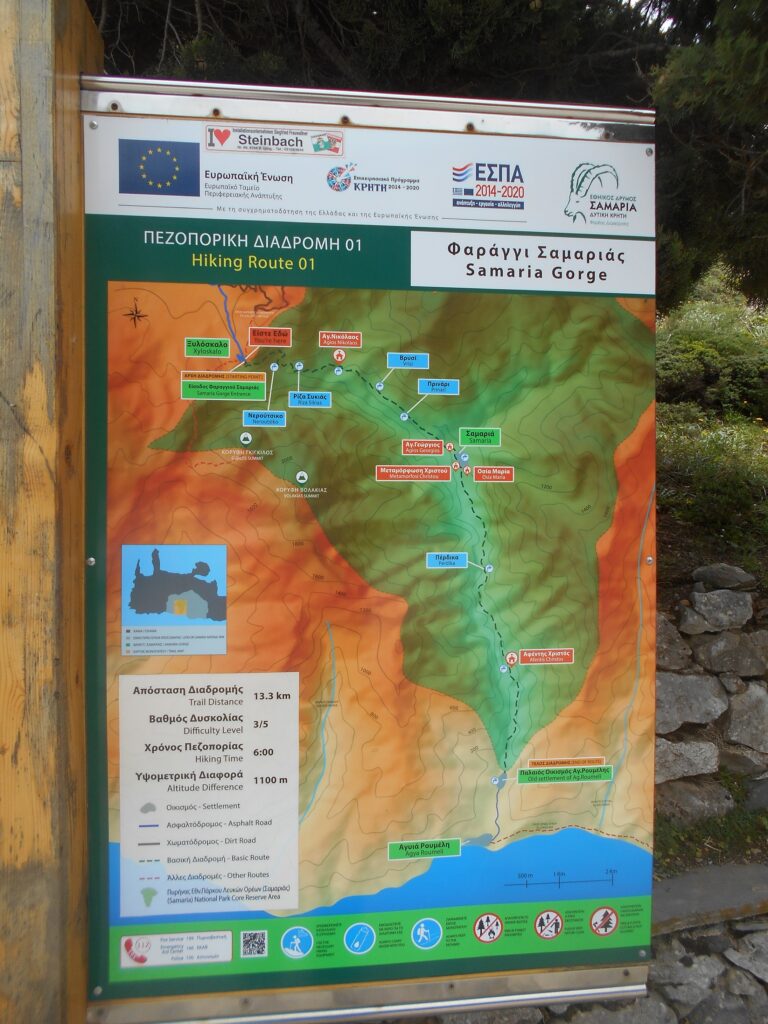
Amazingly, in 14 years of Explore ! we’ve never been down the Samaria Gorge. So let’s put that
straight, with an afternoon descent in early May, very few walkers on the path, and an overnight
stay in Agia Roumeli.
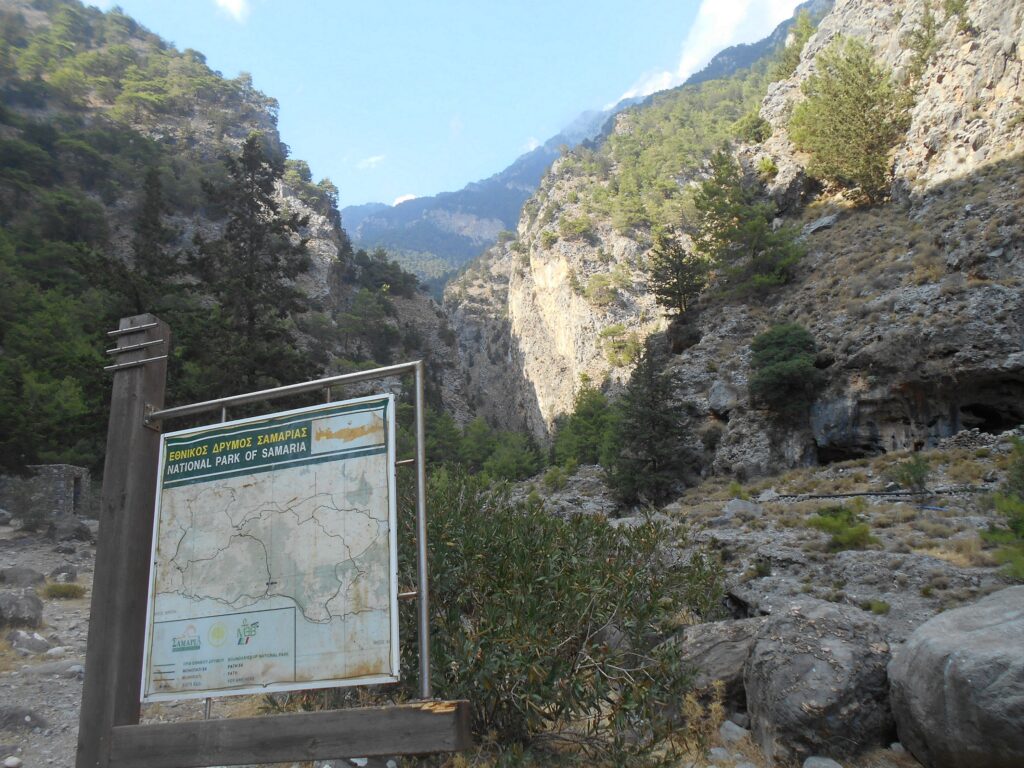
First some facts. The National Park of Samaria was established in 1962, covering an area of 4,850
hectares. The trail down the gorge begins from Xyloscala, on the Omalos plateau, and descends
from 1,230m (4,035ft) to sea level and the Libyan Sea. From entrance to exit measures 13.3 km,
with a further 3km into Agia Roumeli. An average time for the walk is between 5 and 7 hrs, with a
Degree of Difficulty 3/5. The Gorge is open from May 1st until late October depending on weather conditions, and from 7am. An entry fee (currently 5 euro) is payable.
An item of interest. In the corner of the car park, opposite the entrance, is a memorial to eleven
members of the KKE …” and dozens more fighters whose identities are unknown,” killed in the
Battle of Samaria in June 1948. More of which later.
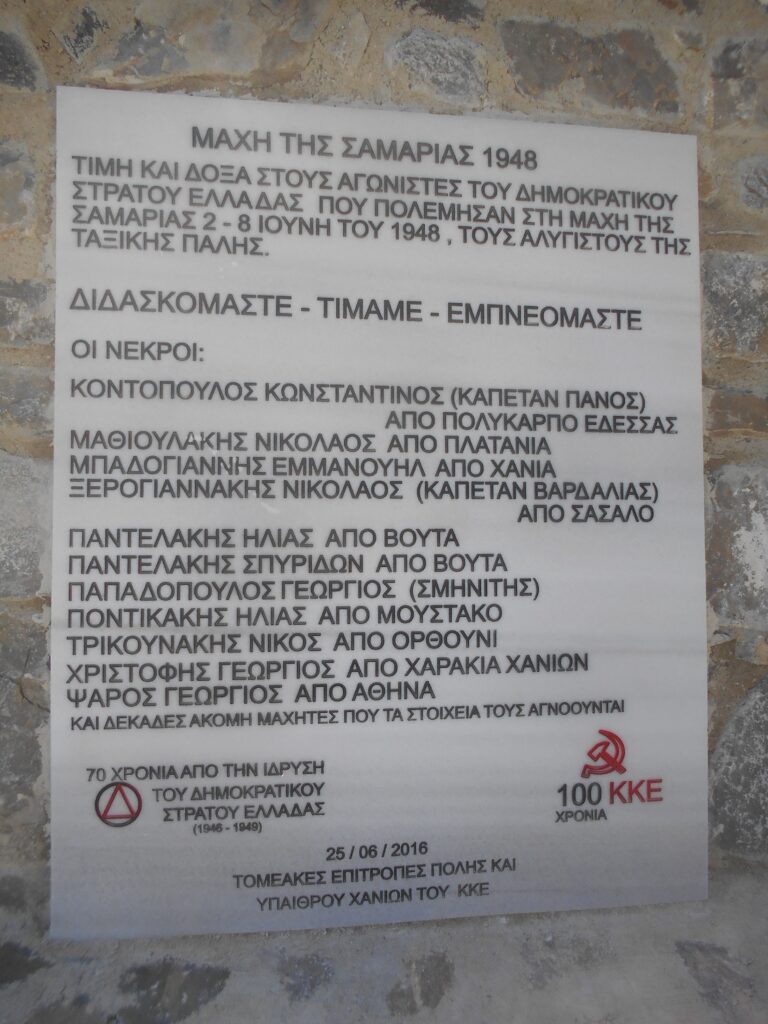
After a taxi from Paleochora, we were the last to set off down the gorge, at exactly 1pm, with
warnings that the last boat left at 5.30pm, and the exit gate would close at 6.pm, neither of which
caused us concern. The massive north face of Gingilos dominates the initial descent, which drops
almost 1000m in the first 2km. On Gingilos are several precarious looking rock climbing routes,
none of which I would contemplate, even in my youth. The summit, at 2,080m is attained by an
easier path (ref. Explore ! April 2014) far less hazardous, and the summit views extensive.
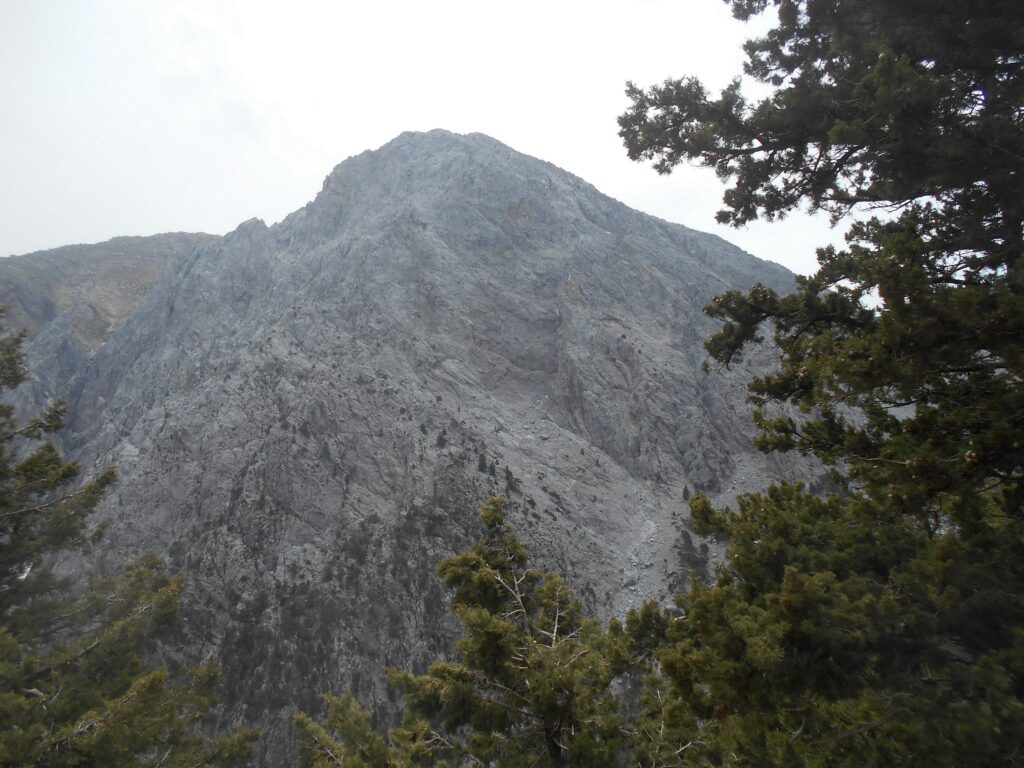
Michelle was slightly ahead, and apart from several, for reasons best known to themselves, walking
UP to Omalos, I was alone in the gorge, with just birdsong, the scent of the pine trees and later
the rippling stream for company. Near the end of the steep section is Ag. Nikolaus church, a place
of worship since Ancient Greek and Roman times.
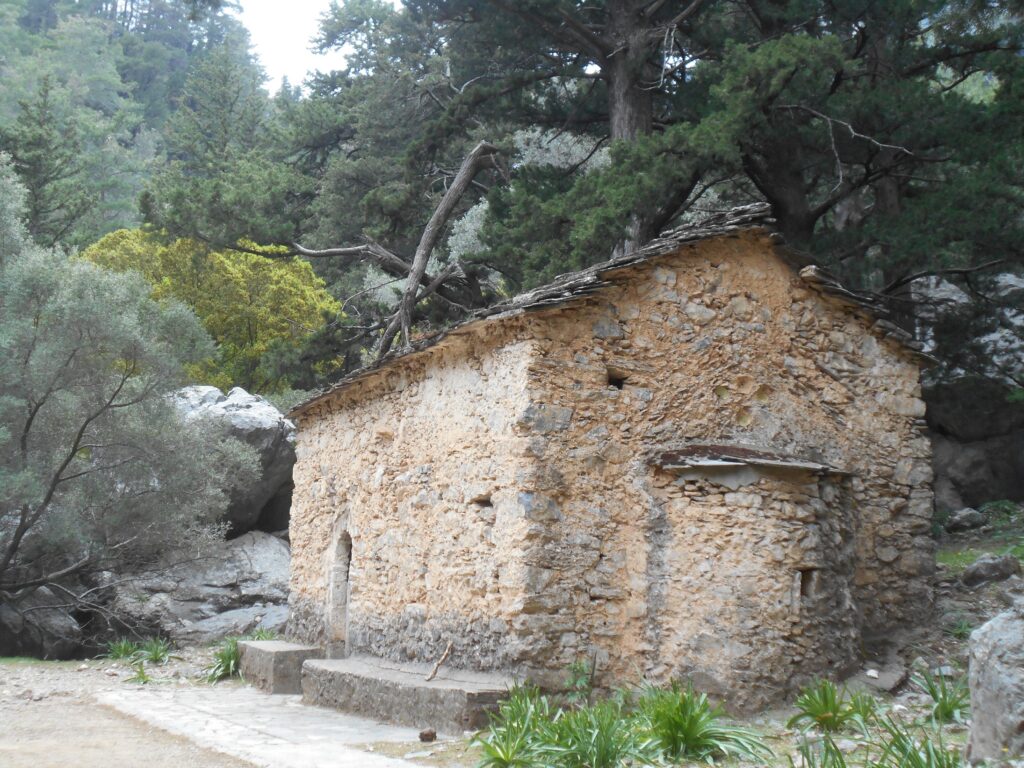
Here there is spring water, toilets, and horses to rescue the lame and limping, and with often over 1000 visitors daily, these are frequent …..
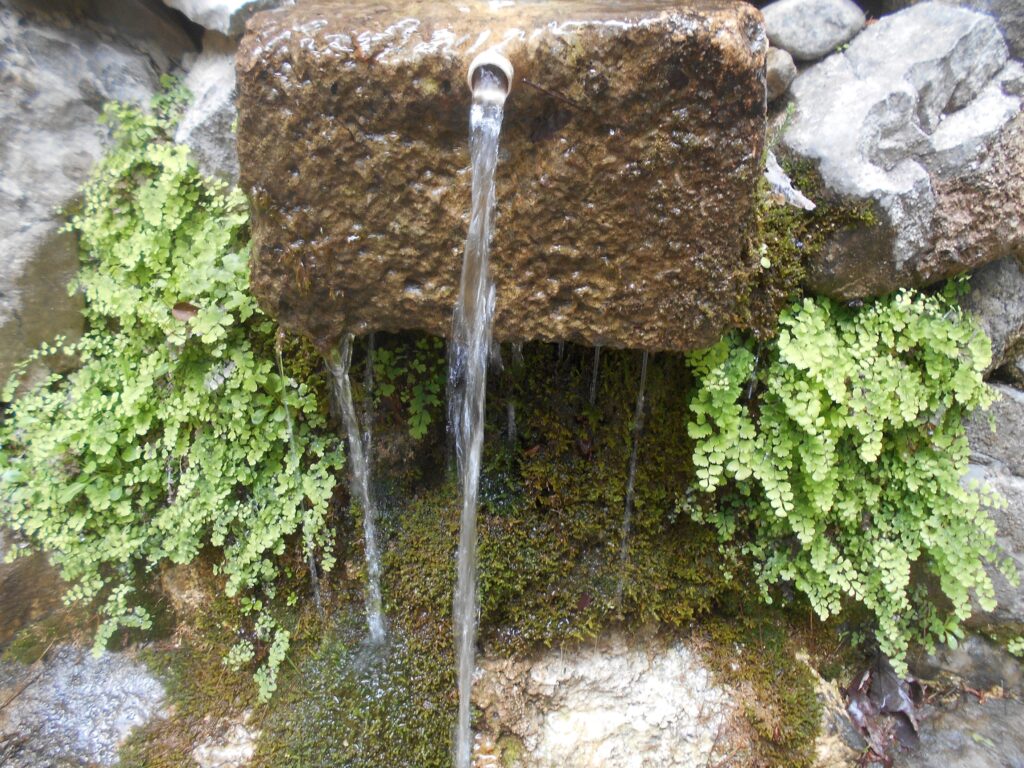
Not always is the gorge as peaceful and placid. Xan Fielding, returning to Crete ten years after his
wartime exploits with the SOE, and visiting partisan friends in Samaria village, wrote : “
Winter had broken the path in a small number of places ; we had to negotiate gaps and screes
which beforehand had never existed. Damage by rain and floods was evident, too, when we reached
the bottom. The stream was swollen into a vicious torrent.” ‘The Stronghold’ – 1953
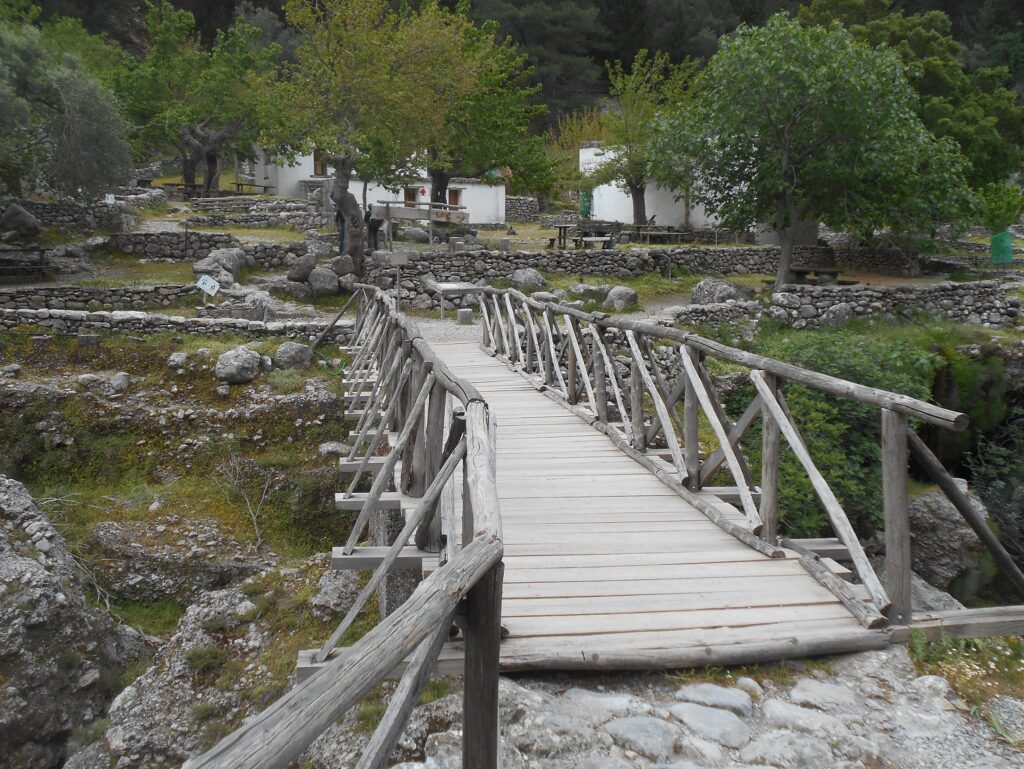
Conditions were similarly hazardous when on the 22nd May 1941, after the German invasion, King
George of Greece, son Prince Peter and Prime Minister Tsouderos were guided down the gorge to
Agia Roumeli, and evacuated to Alexandria on the British destroyer HMS Decoy.
The settlement of Samaria – the name derives from the church of Santa Maria of Egypt, b.1379 –
was populated until 1962, when residents were moved to old Agia Roumeli as the National Park was
developed. Now there is a Warden Centre, First Aid post, picnic tables, water and toilets. In the
early morning, or late afternoon, here are possible glimpses of the endangered Cretan wild goat, or
“kri-kri” whose main residence is in the National Park.
In the summer of 1948, at the height of the Greek Civil War, around a thousand Government
forces trapped and heavily outnumbered several hundred KKE fighters who had sought refuge in
Samaria village. All the exits were sealed, and troops moved down the gorge. Between 2nd/8th
June, fierce fighting resulted in many fatalities and casualties on both sides. But under cover of
darkness, the majority of the guerrillas escaped the confines of the gorge by a little-known path
from Prinias over Volakias mountain, and fled. Incredibly, two of these, who later became known as
the “Eagles of Crete”, remained ‘Wanted’ and on the run from authorities until they surrendered
under an Amnesty in February 1975. *
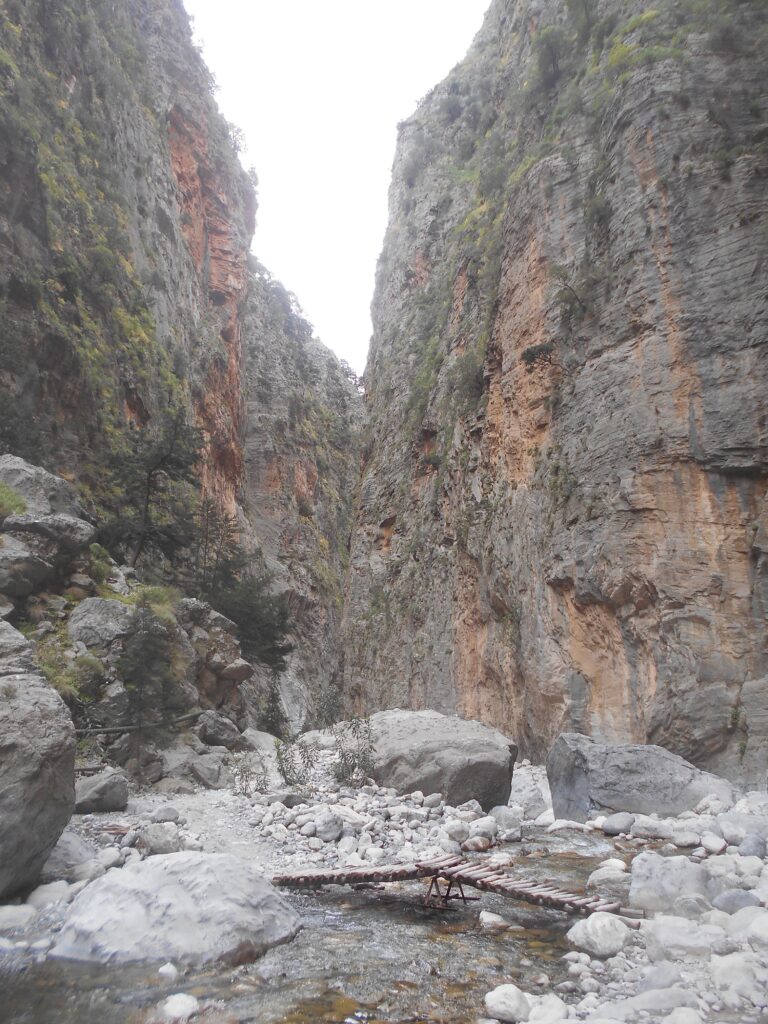
A concerned Ranger asked us if all was well, pointed out that we were only half-way, and that it was
now four o’clock. At a slightly raised pace, and on easier terrain, the gorge widened, then narrowed
to reach ‘Portes’, or Iron Gates, where just 3m separates cliffs rising sheer to 300m.
Despite the dry winter, and below average snowfall, the Tarraios river flowed, and was crossed
several times by wooden footbridges.
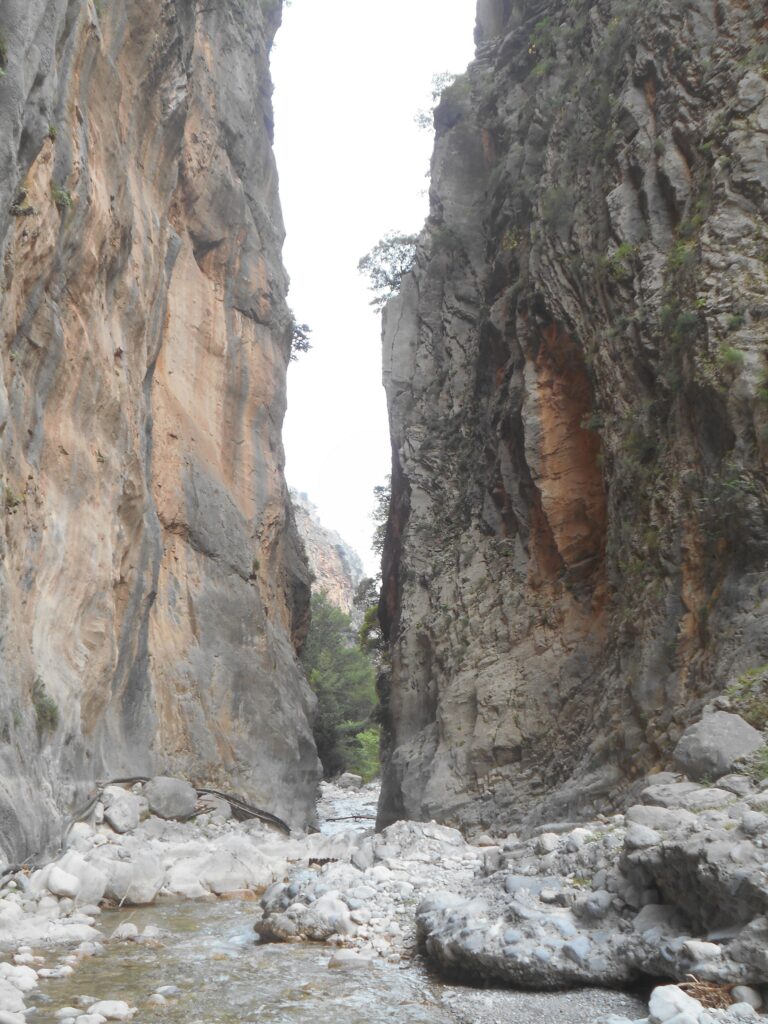
A further 1.5km took us to the Exit, the last of c.800 to arrive, although we had seen only a few.
We declined the temptation of the “shuttle bus”, and walked the final kilometre into Agia Roumeli
and the hospitality of old friends at the Calypso hotel.
In the early years of the Samaria Gorge, walkers travelled to Paleochora in an open boat, which
towed two similar craft, probably an unnerving and uncomfortable two-hour voyage. After a day’s
rest and relaxation, we returned home in comparative luxury on board the Good Ship Samaria.
‘The Eagles of Crete’ : An Untold Story of the Civil War. Colin Janes 2013


3 comments
Kalimera, Agía Rouméli has 3 very different faces: early season, late season and winter.
In the early and late season, the dog is buried in Agía Rouméli. By the end of October 2020, 95% of the tavernas and accommodation had already closed. I think more than 2 – 3 at most 4 tavernas were no longer open.
I stayed with Stelios at Pachnes in Agía Rouméli from 21 May to 22 May 2021. At night, the village is wonderfully quiet and the air is very clear.
In the evening I watched the Greek Cup final (Kypello Elladas) OLY – PAOK in the Paralia taverna. During the season, Taverna Paralia is the top dog and always packed. Now I was sitting here with the family and a handful of locals.
In summer, hundreds of canyon hikers fill the tavernas in the afternoon and wait for the ferry. For a few years now, many tavernas have been serving fast food during the hiking season. There are signs everywhere advertising hamburgers and draught beer. It’s fast and apparently goes down well with the gorge hikers. The crowds and commercialism are hard to take.
There is a mad rush. When the hikers take the ferry at 5.30pm, a heavenly calm descends on the village. Only a few guests and a handful of wild campers are still to be found in Agía Rouméli.
In winter, only a handful of shepherds and workers can be found in Agía Rouméli. Most families go to Ágios Ioánnis.
Then only Nektarios’ tavern Faragi is open. From November to March, a room costs €12. The two mini markets are closed in winter.
There are many interesting things to discover in Agía Rouméli: the old village of Palea Agía Rouméli, abandoned since 1954 (a person from Pakistan lives here with a few animals), the Kastro above Agía Rouméli, the Byzantine church Panagía Kerá, on the ruins of the Apollo temple, the archaeological site of Tarra, the cave chapel Ágios Antónios…
Crete’s rich history has left many traces in this area…
Many greetings from Hamburg, kv
Very astute comments, thanks. Apart from between around 2pm and 5.30pm when the ferries leave, or out of summer season, Agia Roumeli is a quiet, peaceful and very pleasant place to spend time. The Explore ! article in October 2019 decribes ten places of interest to visit, some challenging and demanding (eg. Domata beach, Eligas gorge, and Agios Pavlos), others (the churches, Old Agia Roumeli, and the Turkish ‘koules’) with easy access. Or simply relax on the beach …..
Kalimera Bob, demanding is also the round hike Agia Roumeli – Agia Paraskevi – Papoures – Kouledaki – Kastro – Ag. Roumeli.
Many greetings from Hamburg, kv